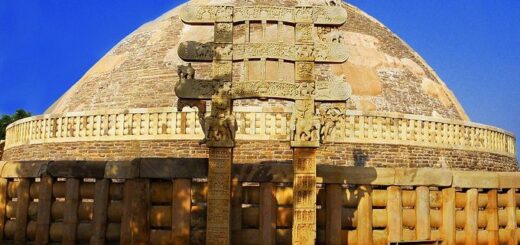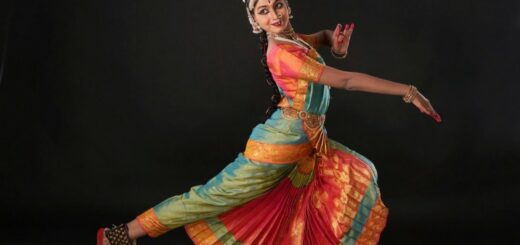Art & Culture: Indian Sculpture
Indus Civilization
- The beginning of stone sculpture in India goes back to a very remote age. The excavations carried out in 1924, at the ruins of Mohenjodaro on the Indus river and Harappa in the Punjab, brought to light a highly developed urban civilization, archaeologically known as the Indus Valley or Harappan Culture.
- It flourished from C.2500 B.C. to 1500 B.C. These ancient cities had a systematic lay-out, wide roads, spacious houses made of bricks, and an underground drainage system, somewhat like our own. People worshipped the Mother Goddess or Goddess of fertility.
- Trade and cultural contacts existed between these cities and those of Mesopotamia of which the evidence is the occurrence of the seals, as well as similar carnelian beads, knobbed pottery, etc., at both places. Clay was the earliest medium in which man began to mould and we have discovered a large number of terracotta figurines from these Indus Valley sites.
Chaitya Hall, Bhaja, Maharashtra
- Among the few stone figurines, a male torso of polished red lime stone from Harappa, chiselled in the round, is remarkable for its naturalistic pose and sophisticated modelling, highlighting its physical beauty.
- This lovely figure makes one wonder how at that remote age, it was possible for the sculptor to carve as beautifully as was done very much later in Greece in the 5th century B.C. The head and arms of this figure were carved separately and socketed into the drilled holes of the torso.
Priest, Clay, Harappa, Pakistan

- Another noteworthy example from this urban culture is the bust portrait of a bearded nobleman or high priest, from Mohenjodaro, weaving a shawl with trefoil pattern. It bears a close resemblance to a similar figure discovered in the Sumerian sites of Ur and Susa.
- The figure of a male dancer belonging to the same period and discovered at Harappa is an important carving showing how music and dance had a great place in life almost 5000 years ago.
- It amply proves the dexterity with which the sculptor 5000 years ago, could catch beautiful movements of dance poses and express them in stone by the graceful twist of the body from the waist upward. Unfortunately, it is in a damaged condition, but it still reflects the great mastery with all its vitality and grace.

- The bronze dancing girl of the same period discovered at Mohenjodaro is perhaps the greatest surviving achievement of the metal work of the Harappan age.
- This world-famous figure shows a female dancing figure standing as if relaxing after a dance number, with her right hand on her hip and the left dangling free. She wears a large number of bangles, probably made of bone or ivory on her left arm together with a couple of pairs on her right arm.
- The statuette is a great master piece of the art of the metal craftsman of the period who knew the art of bronze casting in the cire perdue or lost-wax process.
- This terracotta figure representing the large sized mother goddess is one of the best preserved and comes from Mohenjodaro.
- The significance of the broad pan-like appendage on either side of the coiffure of the goddess is not easily understood. Since she is the bestower of fertility and prosperity, she was worshipped for this very purpose. India is traditionally a country where more than 80 per cent of its inhabitants are agriculturists who naturally worship gods and goddesses of fertility and prosperity. The pinched nose and ornamentation flatly laid on the body and pressed on to the figure and the general folk effect in art are most interesting. The sculptor at Mohenjodaro was adept in his art and could fashion both realistically as well as stylistically.
Bull, bronze, Mohen-jo-daro, Pakistan

- The terracotta figure representing a bull is a forceful representation, eloquently proclaiming the special study of the anatomy of the animal by the modeller who fashioned the figure. The animal is shown standing with his head turned to the right and there is a cord around the neck.
- The pair of squirrels is interesting in a very natural and characteristic fashion seated on their haunches and nibbling at some fruit.
- The toy animal, with a moveable head from Mohenjodaro, belonging to the same period i.e. 2500 B.C., is one of the most interesting objects found during the excavations which shows how the children were kept amused and happy with toys that they could manipulate by moving their heads with the help of a string.
Seals:
- A large number of seals have been discovered in the excavations. They are made of terracotta and copper and are of various shapes and sizes.
- Generally they are rectangular, some are circular and few are cylindrical. Almost invariably they bear on them the representation of a human or an animal figure and have on top an inscription in pictographic script which has not been deciphered so far.

Seal : Pasupati, Stone, Mohen-jo-daro
- This seal shows a seated figure of a Yogi, probably Shiva Pashupati, surrounded by four animals – a rhino, a buffalo, an elephant and a tiger.
- There are two deer shown under the throne. Pashupati means the lord of animals. This seal may throw light on the religion of the Harappan age.
- Most of these seals have a knob at the back through which runs a hole and it is believed that they were used by different guilds or merchants and traders for stamping purposes. When not in use they could be worn round the neck or the arm like an amulet.
Animal Sculptures:
Toy animal with movable head, Terracotta

- A fine example of an animal study shows a humped Brahmini bull of great strength and vigour. It is a great artistic achievement of that early date. The modelling of the fleshy part of the bull’s body is very realistically depicted.
- There are small seals of intricate workmanship and of great artistic merit, astonishing examples of the artistic skill of the sculptors. Such exquisite works of art could not have come about overnight and clearly suggest a long previous tradition.
- Harappa and Mohenjodaro are now in West Pakistan. About a hundred sites of this culture, have been found in India, and a few of them excavated so far, have disclosed that the Indus culture was spread over an extensive area.
Evolution of Sculptures:
- The Indus civilization came to an end in about C.1500 B.C. probably due to the Aryan invasion of India. Except for some antiquities of the copper hoard culture and ceramics, no trace of any plastic art is found during the next 1000 years.
- This may perhaps be due to perishable materials like wood which were used in fashioning art forms which could not withstand the rigors of time.
- The carvings of flat surface, as met with at Bharhut and Sanchi, are an echo of an earlier tradition in wood or ivory.
- But this intervening period of about 1000 years is important, because it was during this time that a synthesis took place between the fertility cults of the Dravidians, who were the original inhabitants of India, and the Aryan elements of rites and rituals.
- The Indian way of life and thought as embodied in the earliest scriptures, the Vedas and the Epic literature, were developed and the blending of the Aryan gods with the more ancient Buddhism and its contemporary religion Jainism, also made their appearance in India in the 6th Century B.C.
- These faiths have much in common with each other and represent the ascetic trend in Hindu philosophy. The teachings of these reformed faiths by Gautama Buddha and Mahavira, had a deep impact on the masses. It is the concept of these three religions, which later found expression in plastic art forms.An these sculptures were originally parts of temples or other religious monuments to which they belonged both aesthetically and functionally.














